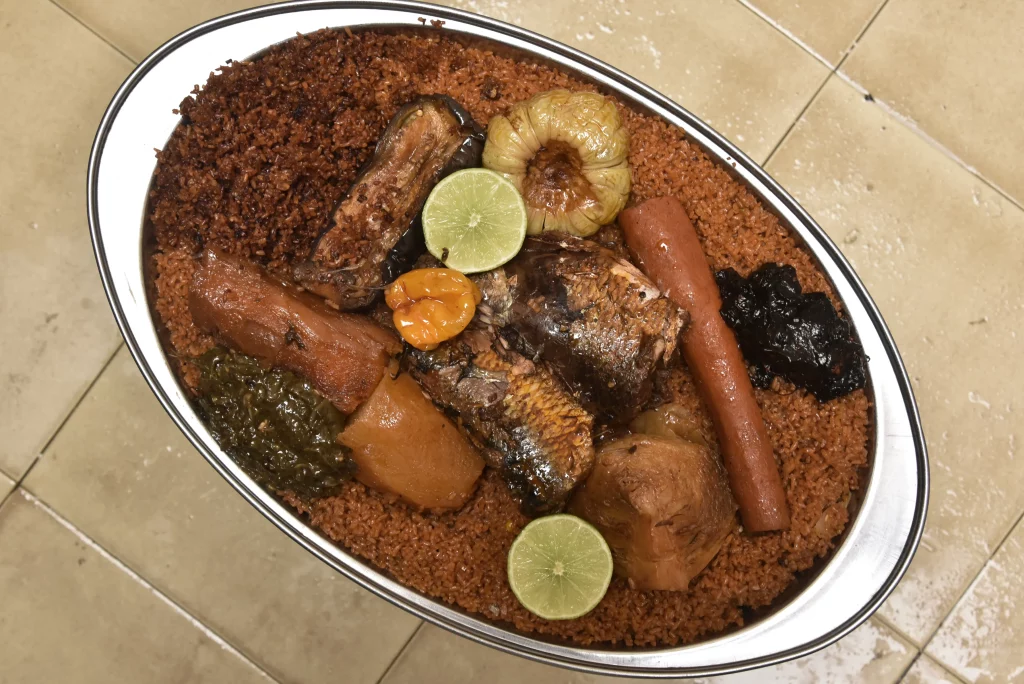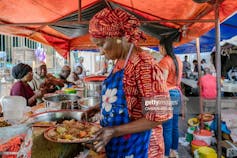
Jolof rice or rice with fish – also called “ceebu jën“, according to the Wolof spelling – has been listed as a UNESCO World Heritage Site at the request of Senegal. Beyond the debate between West African nations on the paternity of this dish, the challenges that await Senegal to take advantage of this recognition are numerous.
The origin of this dish is linked, first of all, to a point in history. Specifically, colonization replaced food crops with broken rice, imported from Indochina. Then will come what we have called in our book Le ceebu jën, a very Senegalese heritage, the stroke of genius of the natives, in particular of the Saint-Louisians.
In this respect, the main curiosity was the following: how to succeed, from what one has not produced, in creating something entirely new. And in this case, for ceebu jën, it is not only rice that is exported. With the exception of fish, practically all its essential components testify, by their origin, to an extroverted economy.
The Penda Mbaye legend
The rice will be the subject of an original treatment, at the end of which will be invented a dish that is unknown both to those who cultivate rice and to vegetable producers. The name of rice with fish is regularly attached to the name of a woman, Penda Mbaye.
If no one disputes this filiation between this dish and this lady, the fact remains that serious information on the identity of this woman, on the place and the time where she lived, and on the conditions of the creation of this dish are cruelly default. That’s why we said in our book that she quickly left history to carve out a place for herself in legend.
The settler will find the appropriate strategy to “hook” his subjects. Act one was to make dependent on rice all those disconnected from agricultural activities, who had come to try to make a fortune in the markets of Saint-Louis, one of the gateways for Westerners and, for a good period, the capital of French West Africa.
Next will follow the peasants, the first victims of the economy disrupted by the programmed disappearance of food crops. If we add to these fringes, the teachers, the various agents of the administration, and the military, we better understand the pernicious process of promoting rice.
Overflowing the urban centers, the rice will be consumed, practically, the essence of the colony of Senegal. And, thanks to the intermingling, the “foreigners”, by marrying Saint-Louisiennes, bring back to their land of origin their “sweet half” who does not miss the opportunity to make their new family taste the delights of rice. to fish.
Combining expertise and coquetry, she will “have fun” serving rice with fish in its different variations: red rice, white rice with goorjigèen sauce – this dish straddling red rice and white rice is called man-woman rice.
Gastro-diplomatic issues
The success of the strategy of promoting rice by the colonial forces resulted in the anchoring of a fundamentally extroverted economy. From independence to the present day, efforts have been made to produce rice in Casamance and in the region of Saint-Louis. In the same movement, the exploitation of market gardening areas of Niayes and Gandiol has contributed to meeting the needs of populations in terms of vegetables.
A highly divergent claim to the paternity of ceebu jën has been noted. However, this controversy has never led to these “wars” which often provoke violent outbursts of which Paul Bocuse, nicknamed “the pope” of French gastronomy, spoke.

For illustration, he points out that when Barack Obama came to Israel in 2013, the Palestinians felt that by serving the American president hummus, their neighbors had committed a “theft of their cultural heritage”. The author indicates that, in addition to hummus, falafel, another highly prized dish from this region, is also the subject of the same “war” between Lebanon and Israel.
Nigerians and Ghanaians have claimed authorship of Jolof rice. But, in our book, we indicate that the “senegality” of this dish is all the more established that the reference to “Jolof”, an ancient kingdom, constitutive of Senegal, is not a simple stylistic clause.
As it happens in history, when art reaches a certain notoriety, its authorship becomes a subject of controversy. In addition, the transformations and different variations undergone by the dish can contribute to blurring historical landmarks.
In this case, when ceebu jën refers exclusively to rice with fish, Jolof rice is suitable, in an undifferentiated way, for meat, chicken, and fish. Undoubtedly, it is an undeniable enrichment, but in the original heritage, there are codes that allow us to distinguish the different types of dishes. We also think that today the question of paternity arouses less and less passion.
Challenges
Since December 2021, Unesco has included ceebu jën on the list of intangible heritage of humanity. This labeling by Unesco of the Senegalese version of rice with fish has, first of all, the merit of valuing what the Senegalese have on two levels. This classification of this culinary art in the treasure of humanity is a recognition of know-how, an integral part of the immaterial heritage. And it’s always good for the minds of Africans. It is also an encouragement to provide a more sustained effort to make local consumption a reality, even a reflex.
This labeling undoubtedly also has very positive effects on the economy, tourism, agriculture, fishing, catering, etc. It is not superfluous either to integrate the stakes within the framework of gastro diplomacy. However, taking advantage of all these advantages requires that Senegal take greater care of its fishery resources and, above all, settle, for good, the recurring question of self-sufficiency in rice to put an end to this scandalous perversion consisting in feeding on what we do not produce.
Senegal, whose reputation is based more on its cultural influence and its diplomacy, has every interest in joining this trend. Thus, it will be up to it to revalorize, in addition to fish rice, all its gastronomic heritage, in order to make it an additional asset for the benefit of the role it intends to play in the concert of nations.
In this spirit, the Institute of Food Technology would find a new lease on life. This public establishment, created in 1963, had been assigned the mission of research and development in food and nutrition.
In this spirit of promoting the rich Senegalese heritage, the institute could set itself the objective of promoting all these remarkable Senegalese consumables made from millet or local fruits. And to meet this challenge, Senegal would be well advised to take advantage of all the proven expertise of research institutions, universities, the National Company for the Development and Exploitation of Land in the Delta and the River Valley ( Saed ), Africa Rice and the various players in its economy.